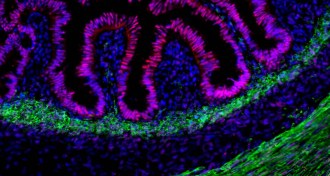Uncategorized
-
 Astronomy
AstronomyA musician composes a solar soundtrack
Robert Alexander combines life long passions of both music and astronomy to uncover solar secrets.
-
 Environment
EnvironmentEngineered plants demolish toxic waste
With help from bacteria, plants could one day clean up polluted sites.
By Beth Mole -
 Humans
HumansAnglo-Saxons left language, but maybe not genes to modern Britons
Modern Britons may be more closely related to Britain’s indigenous people than they are to the Anglo-Saxons, a new genetic analysis finds.
-
 Physics
PhysicsLaser tractor beam tugs on beads
A new experiment is the first to construct a tractor beam that can pull objects over long distances with light.
By Andrew Grant -
 Genetics
GeneticsGene variant helps dog evade muscular dystrophy
A dog that has a mutation causing muscular dystrophy has another genetic variant that appears to counteract the disease.
-
 Science & Society
Science & SocietyTwo books explore winding path from basic science to useful invention
‘How We Got to Now’ and ‘Science Unshackled’ explain how basic scientific research can transform society in unexpected ways.
By Sid Perkins -
 Physics
PhysicsPerfect fluid of electrons may flow inside superconductor
Understanding superconductors’ viscosity could help inspire scientists to find ways to improve the electric power grid.
By Andrew Grant -
 Psychology
PsychologyMajority doesn’t always rule in teen booze use
Having one abstainer as a friend cuts teens’ odds of getting drunk and binge drinking, a study finds.
By Bruce Bower -
 Physics
PhysicsComplete double rainbow encircles Australian town
A photographer in a helicopter captured a double circular rainbow while flying around a storm near Perth, Australia.
-
 Cosmology
Cosmology‘The Theory of Everything’ reveals Stephen Hawking’s personal side
A new film explores love and science in the life of physicist Stephen Hawking.
By Andrew Grant -
 Health & Medicine
Health & MedicineTiny human intestine grown inside mouse
Human gut tissue transplanted into a mouse can grow into a working intestine that doctors could use to test disease treatments.
By Meghan Rosen -
 Planetary Science
Planetary Science‘Mars Rover Curiosity’ chronicles robot’s journey
Engineer Rob Manning recounts the decade of victories and setbacks that preceded Curiosity’s landing on Mars.